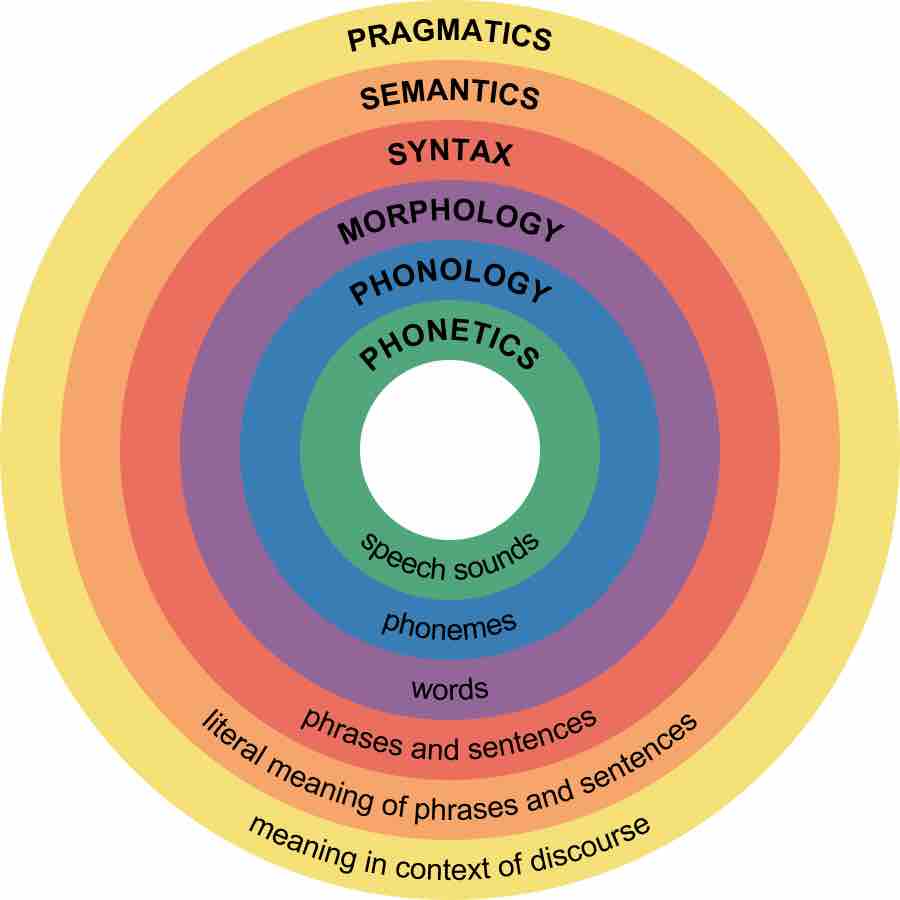Every language is different. In English, an adjective comes before a noun ("red house"), whereas in Spanish, the adjective comes after ("casa [house] roja [red].") In German, you can put noun after noun together to form giant compound words; in Chinese, the pitch of your voice determines the meaning of your words; in American Sign Language, you can convey full, grammatical sentences with tense and aspect by moving your hands and face. But all languages have structural underpinnings that make them logical for the people who speak and understand them.
Five major components of the structure of language are phonemes, morphemes, lexemes, syntax, and context. These pieces all work together to create meaningful communication among individuals.

Major levels of linguistic structure
This diagram outlines the relationship between types of linguistic units. Speech sounds make up phonemes, which make up words. Words make up sentences, which have literal meanings and contextual meanings.
Phonemes
A phoneme is the basic unit of phonology. It is the smallest unit of sound that may cause a change of meaning within a language, but that doesn't have meaning by itself. For example, in the words "bake" and "brake," only one phoneme has been altered, but a change in meaning has been triggered. The phoneme /r/ has no meaning on its own, but by appearing in the word it has completely changed the word's meaning!
Phonemes correspond to the sounds of the alphabet, although there is not always a one-to-one relationship between a letter and a phoneme (the sound made when you say the word). For example, the word “dog” has three phonemes: /d/, /o/, and /g/. However, the word "shape," despite having five letters, has only three phonemes: /sh/, /long-a/, and /p/. The English language has approximately 45 different phonemes, which correspond to letters or combinations of letters. Through the process of segmentation, a phoneme can have a particular pronunciation in one word and a slightly different pronunciation in another.
Morphemes
Morphemes, the basic unit of morphology, are the smallest meaningful unit of language. Thus, a morpheme is a series of phonemes that has a special meaning. If a morpheme is altered in any way, the entire meaning of the word can be changed. Some morphemes are individual words (such as "eat" or "water"). These are known as free morphemes because they can exist on their own. Other morphemes are prefixes, suffixes, or other linguistic pieces that aren’t full words on their own but do affect meaning (such as the "-s" at the end of “cats” or the "re-" at the beginning of “redo.”) Because these morphemes must be attached to another word to have meaning, they are called bound morphemes.
Within the category of bound morphemes, there are two additional subtypes: derivational and inflectional. Derivational morphemes change the meaning or part of speech of a word when they are used together. For example, the word "sad" changes from an adjective to a noun when "-ness" (sadness) is added to it. "Action" changes in meaning when the morpheme "re-" is added to it, creating the word "reaction." Inflectional morphemes modify either the tense of a verb or the number value of a noun; for example, when you add an "-s" to "cat," the number of cats changes from one to more than one.
Lexemes
Lexemes are the set of inflected forms taken by a single word. For example, members of the lexeme RUN include "run" (the uninflected form), "running" (inflected form), and "ran." This lexeme excludes "runner" (a derived term—it has a derivational morpheme attached).
Another way to think about lexemes is that they are the set of words that would be included under one entry in the dictionary—"running" and "ran" would be found under "run," but "runner" would not.
Syntax
Syntax is a set of rules for constructing full sentences out of words and phrases. Every language has a different set of syntactic rules, but all languages have some form of syntax. In English, the smallest form of a sentence is a noun phrase (which might just be a noun or a pronoun) and a verb phrase (which may be a single verb). Adjectives and adverbs can be added to the sentence to provide further meaning. Word order matters in English, although in some languages, order is of less importance. For example, the English sentences "The baby ate the carrot" and "The carrot ate the baby" do not mean the same thing, even though they contain the exact same words. In languages like Finnish, word order doesn’t matter for general meaning—different word orders are used to emphasize different parts of the sentence.
Context
Context is how everything within language works together to convey a particular meaning. Context includes tone of voice, body language, and the words being used. Depending on how a person says something, holds his or her body, or emphasizes certain points of a sentence, a variety of different messages can be conveyed. For example, the word "awesome," when said with a big smile, means the person is excited about a situation. "Awesome," said with crossed arms, rolled eyes, and a sarcastic tone, means the person is not thrilled with the situation.